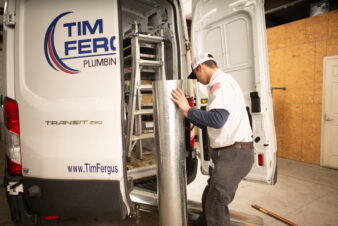Mechanical Hub presents this multi-part series on pressing technology. Every week MH will feature a Q&A with the leaders in pressing technology. Press technology is gaining momentum as the preferred choice in pipe joining. Introduced into the North American market in 1999 by Viega, pressing is gaining acceptance as the most efficient and cost effective method of joining piping materials. Press currently makes up nearly 12% of the copper fitting market, and that number is expected to rise with contractor education and training.
Mechanical Hub recently talked with some of the major players in the press technology market to learn more about what they are doing in this growing market.
Part 3 of the series continues with an exclusive interview with Rob Trefz, P.E., Director of Marketing, Pipe Installation and Maintenance Products, RIDGID.
MH: Name some of the applications in which pressing is ideal?
RT: Pressing is ideal in all applications involving ½” to 4” copper and stainless steel tubing. It is faster than soldering, especially when dealing with larger applications. The larger the diameter of the connection, the more time pressing can save. Additionally, pressing is an excellent alternative to soldering when dealing with applications where the water can’t be shut off. For example, if a valve is leaking it is extremely difficult, if not impossible, to solder a connection when there is water in the line. Pressing can be done on a wet system. Pressing also eliminates the need for an open flame, which, in turn, eliminates the need for a fire watch or a burn permit that is required on some jobsites.
MH: What is the scope of press piping? Copper, PEX, Stainless, Iron, etc.?
RT: Copper and stainless tubing ½” to 4” in diameter and PEX and steel pipe ½” – 2”. RIDGID press tools can also be used to cut soil pipe.
MH: Are your pressing tools proprietary? Or can they be interchangeable with other manufacturer's pressing clamps and fittings?
RT: We recommend using RIDGID jaws with RIDGID press tools.
MH: I have heard the pressing is used predominantly in Europe. Why has it taken the North American market so long to catch on?
RT: Pressing technology was initially developed and implemented in Europe; however, pressing has been adopted in North America as well. In fact, contractors have been using RIDGID pressing tools in North America for over 12 years now.
MH: To that last point, can you guesstimate the pressing market in the U.S. as opposed to sweating and other pipe joining methods?
RT: Press fittings are a significant portion of the US fitting market and are gaining a larger share each year. One reason for this is that contractors, especially in the recent slow economy, have been forced to be as competitive as possible to win bids. Pressing saves time on the job, which allows contractors to bid more competitively.
MH: Is pressing technology continually evolving? (effectiveness, ergonomics, weight, cordless & battery efficiency, larger pipe diameters, etc.)
RT: Pressing technology is definitely evolving in both tool technology and material capabilities. The size and weight of RIDGID tools have continuously been reduced with each new model. RIDGID was the first to introduce a lithium ion battery on a press tools. Most recently, RIDGID has introduced pressing jaws for use on standard, off-the-shelf, steel pipe.
MH: I have used the pressing tools so the obvious question would be, why wouldn't contractors use pressing technology?
RT: Most people who have used pressing have liked it. And contractors continue to adopt it. If they haven’t tried it, they should call us (1-800-769-7743) to discuss the benefits and get a product demonstration.
For more information, www.ridgid.com.
Rob Trefz, P.E., is the Director of Marketing, Pipe Installation and Maintenance Products, RIDGID.





Join the conversation: